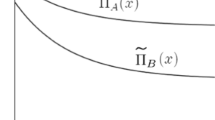Abstract
We study a mathematical model for the coupled dynamics of human socio-economic choice and lake water system. In the model, many players choose one of the two options: a cooperative and costly option with low phosphorus discharge, and an economical option with high phosphorus discharge. The choice is affected by an economic cost, a social concern about water pollution, and a conformist tendency. The pollution level in the lake is determined by total phosphorus discharge by the players, the sedimentation and the outflow of phosphorus, and the recycling of phosphorus from the sediment. The model has two sources of nonlinearity: the cooperation level tends to be bistable due to conformist tendency of people (social hysteresis) and pollution level tends to be bistable because phosphorus recycling occurs faster in more eutrophic lakes (ecological hysteresis). The combination of these two sources may cause multiple stable equilibria or oscillations with a long periodicity. Small economic cost and strong social concern about pollution level can decrease the pollution level, but may not be very effective in enhancing the cooperation level. In contrast, strong conformist tendency produces a stable state with a high cooperation level and a low pollution level. We discuss implications of these results to the water quality management.







Similar content being viewed by others
References
Amemiya T, Enomoto T, Rossberg AG, Takamura N, Itoh K (2005) Lake restoration in terms of ecological resilience: a numerical study of biomanipulations under bistable conditions. Ecol Soc 10(2):3. http://www.ecologyandsociety.org/vol10/iss2/art3/
Beisner BE, Dent CL, Carpenter SR (2003) Variability of lakes on the landscape: roles of phosphorus, food webs, and dissolved organic carbon. Ecology 84:1563–1575. doi:10.1890/0012-9658(2003)084[1563:VOLOTL]2.0.CO;2
Boyd R, Richarson RJ (1996) Why culture is common, but cultural evolution is rare. Proc Br Acad 88:77–93
Brock WA, de Zeeuw A (2002) The repeated lake game. Econ Lett 76:109–114. doi:10.1016/S0165-1765(02)00030-7
Brock WA, Mäler K-G, Perrings C (2001) Resilience and sustainability: the economic analysis of nonlinear dynamic systems. In: Gunderson LH, Holling CS (eds) Panarchy. Kluwer Academic Publishers, Dordrecht
Carpenter SR (2005) Eutrophication of aquatic ecosystems: bistability and soil phosphorus. Proc Natl Acad Sci USA 102:10002–10005. doi:10.1073/pnas.0503959102
Carpenter SR, Ludwig D, Brock WA (1999a) Management of eutrophication for lakes subject to potentially irreversible change. Ecol Appl 9:751–771. doi:10.1890/1051-0761(1999)009[0751:MOEFLS]2.0.CO;2
Carpenter SR, Brock WA, Hanson P (1999b) Ecological and social dynamics in simple models of ecosystem management. Conserv Ecol 3(2): 4. http//www.consecol.org/vol3/iss2/art4/
Clark C (1990) Mathematical bioeconomics: the optimal management of renewable resources, 2nd edn. Wiley, New York
Dechert WD, O’Donnell SI (2006) The stochastic lake game: a numerical solution. J Econ Dyn Control 30:1569–1587. doi:10.1016/j.jedc.2005.10.010
Fehr E, Gächter S (2000) Cooperation and punishment in public goods experiments. Am Econ Rev 90:980–994
Fischbacher U, Gächter S, Fehr E (2001) Are people conditionally cooperative? Evidence from a public goods experiment. Econ Lett 71:397–404. doi:10.1016/S0165-1765(01)00394-9
Gächter S, Fehr E (1999) Collective action as a social exchange. J Econ Behav Organ 39:341–369. doi:10.1016/S0167-2681(99)00045-1
Genkai-Kato M, Carpenter SR (2005) Eutrophication due to phosphorus recycling in relation to lake morphometry, temperature, and macrophytes. Ecology 86:210–219. doi:10.1890/03-0545
Grüne L, Kato M, Semmler W (2005) Solving ecological management problems using dynamic programming. J Econ Behav Organ 57:448–473. doi:10.1016/j.jebo.2005.04.002
Gunderson LH, Holling CS (2001) Panarchy. Island Press, Washington, DC
Harbaugh WT, Mayr U, Burghart DR (2007) Neural responses to taxation and voluntary giving reveal motives for charitable donations. Science 316:1622–1625. doi:10.1126/science.1140738
Henrich J, Boyd R (1998) The evolution of conformist transmission and the emergence of between-group differences. Evol Hum Behav 19:215–241. doi:10.1016/S1090-5138(98)00018-X
Hofbauer J, Sigmund K (2003) Evolutionary game dynamics. Bull Am Math Soc 40:479–519. doi:10.1090/S0273-0979-03-00988-1
Iwasa Y, Uchida T, Yokomizo H (2007) Nonlinear behavior of the socio-economic dynamics for lake eutrophication control. Ecol Econ 63:219–229. doi:10.1016/j.ecolecon.2006.11.003
Kareiva P (2006) Conservation biology: beyond marine protected areas. Curr Biol 16:R533–R535. doi:10.1016/j.cub.2006.06.043
Ludwig D, Brock WA, Carpenter SR (2005) Uncertainty in discount models and environmental accounting. Ecolo Soc 10(2): 13 http://www.ecologyandsociety.org/vol10/iss2/art13/
Mäler K-G, Xepapadeas A, de Zeeuw A (2003) The economics of shallow lakes. Environ Resour Econ 26:603–624. doi:10.1023/B:EARE.0000007351.99227.42
Milinski M, Semmann D, Krambeck HJ (2002a) Donors to charity gain in both indirect reciprocity and political reputation. Proc R Soc Lond B Biol Sci 269:881–883. doi:10.1098/rspb.2002.1964
Milinski M, Semmann D, Krambeck HJ (2002b) Reputation helps solve the tragedy of the commons. Nature 415:424–426. doi:10.1038/415424a
Milinski M, Semmann D, Krambeck H, Marotzke J (2006) Stabilizing the earth’s climate is not a losing game: supporting evidence from public goods experiments. Proc Natl Acad Sci USA 103:3994–3998. doi:10.1073/pnas.0504902103
Murray JD (2002) Mathematical biology, 2nd edn. Springer, Berlin Heidelberg New York
Ostrom E (1990) Governing the commons. Cambridge University Press, Cambridge
Pillutla MM, Chen X-P (1999) Social norms and cooperation in social dilemmas: the effects of context and feedback. Organ Behav Hum Decis Process 78:81–103. doi:10.1006/obhd.1999.2825
Potters J, Sefton M, Vesterlund L (2005) After you: endogenous sequencing in voluntary contribution games. J Public Econ 89:1399–1419. doi:10.1016/j.jpubeco.2004.02.008
Satake A, Iwasa Y (2006) Coupled ecological and social dynamics in a forested landscape: the deviation of individual decisions from the social optimum. Ecol Res 21:370–379. doi:10.1007/s11284-006-0167-9
Satake A, Janssen M, Levin SA, Iwasa Y (2007) Synchronized deforestation induced by social learning under uncertainty of forest-use value. Ecol Econ 63:452–462. doi:10.1016/j.ecolecon.2006.11.018
Scheffer M (2004) Ecology of Shallow Lakes. Kluwer Academic Publishers, Dordrecht
Scheffer M, Carpenter SR (2003) Catastrophic regime shifts in ecosystems: linking theory to observation. Trends Ecol Evol 18:648–656. doi:10.1016/j.tree.2003.09.002
Scheffer M, Carpenter SR, Foley JA, Folke C, Walker B (2001a) Catastrophic shifts in ecosystems. Nature 413:591–596. doi:10.1038/35098000
Scheffer M, Westley F, Brock WA, Holmgren M (2001b) Dynamic interaction of societies and ecosystems—linking theories from ecology, economy, and sociology. In: Gunderson LH, Holling CS (eds) Panarchy. Kluwer Academic Publishers, Dordrecht
Takamura N, Kadono Y, Fukushima M, Nakagawa M, Kim B-HO (2003) Effects of aquatic macrophytes on water quality and phytoplankton communities in shallow lakes. Ecol Res 18:381–395. doi:10.1046/j.1440-1703.2003.00563.x
Acknowledgments
This work was supported by the Environmental Technology Development Fund “Study of new evaluation and management method, for the restoration project of healthy lake ecosystems,” (PI is Dr. Noriko Takamura, at NIES, Japan), and also by Grants-in-Aids from JSPS to Y.I. We thank the following people for their very helpful discussion: U. Dieckmann, A. Satake, N. Takamura, and H. Yokomizo.
Author information
Authors and Affiliations
Corresponding author
Appendix
Appendix
Response to additional increase in recycling rate
The water pollution level can be lowered by a small difference of economic cost c or a large social concern κ, as well as by enhanced conformist tendency ξ. However, human activity may change parameter values in the dynamics of the pollution level in the lake. For example, water level control and bank protection works can modify the rate of limnological process, such as the recycling rate r. Then, we may ask which equilibrium is robust to additional nutrient load, such as a further enhancement of phosphorus recycling rate r.
Figure 8a and b illustrates that strong conformist tendency ξ makes the lake system robust to a further change of the recycling rate r. The isoclines for the pollution level are illustrated by broken line (r = 0.9) and bold broken line (r = 1), and the isoclines for the cooperation level are illustrated by solid line (ξ = 2) and bold solid line (ξ = 4). When r = 0.9 (I, broken line) and ξ = 2 (II, solid line), there is an unstable equilibrium A. When ξ increases to 4 (III, bold solid line), two stable equilibria (B, C) emerge. Fig. 8b shows the change of dynamics when ξ changes from 2 to 4 at time 1,000 (indicated by solid arrow), and r changes from 0.9 to 1 at time 2,000 (open allow). The cooperation level and the pollution level reach equilibrium C because the domain of attraction of equilibrium B is very small. The stable equilibrium C does not change when r changes to 1 (IV, bold broken line). The equilibrium of high cooperation level and low pollution level is robust to a further change of r (Fig. 8b).
Response to additional increase in recycling r. a The isocline for the pollution level (broken line, bold broken line) and the isocline for the cooperation level (solid line, bold solid line). Isoclines with r = 0.9 (I, broken line), ξ = 2 (II, solid line), ξ = 4 (III, bold solid line), and r = 1 (IV, bold broken line). b The change of dynamics when ξ changes from 2 to 4 at time 1,000 (indicated by solid arrow), and r changes from 0.9 to 1 at time 2,000 (open arrow). c Isoclines with c = 8 (II, solid line), and c = 5.5 (III, bold solid line). The others are the same as in a. d The change of dynamics in the case of c. e Isoclines with c = 4 (III, bold solid line). The others are the same as in c. f The change of dynamics in the case of e. The standard set of parameters are: s = 0.01, γ = 2, c = 8, ξ = 2, κ = 1.6, α = 0.5, p H = 0.12, p L = 0.01, m = 1, and q = 2
In contrast, mildly reduced c cannot keep the pollution level low (Fig. 8c, d). When c is reduced from c = 8.0 (II) to c = 5.5 (III), cooperation level and pollution level reach stable equilibrium B of low pollution level and low cooperation level. However, increase of r (IV) arises stable equilibrium C of high pollution level. When r increases, the cooperation level and the pollution level jump from B to C (Fig. 8d). The equilibrium of low pollution level by mildly increased κ shows a similar response of the case of mildly reduced c.
A very large reduction of c or a very large enhance of κ can arise robust equilibrium B against the increase of r (Fig. 8e, f), but ξ seems to increase the cooperation level more than c and κ (Fig. 6). Hence, we consider that a greater conformist tendency ξ is more effective in restricting regime shift by additional recycling rate r than reduced c or enhanced κ.
About this article
Cite this article
Suzuki, Y., Iwasa, Y. The coupled dynamics of human socio-economic choice and lake water system: the interaction of two sources of nonlinearity. Ecol Res 24, 479–489 (2009). https://doi.org/10.1007/s11284-008-0548-3
Received:
Accepted:
Published:
Issue Date:
DOI: https://doi.org/10.1007/s11284-008-0548-3





